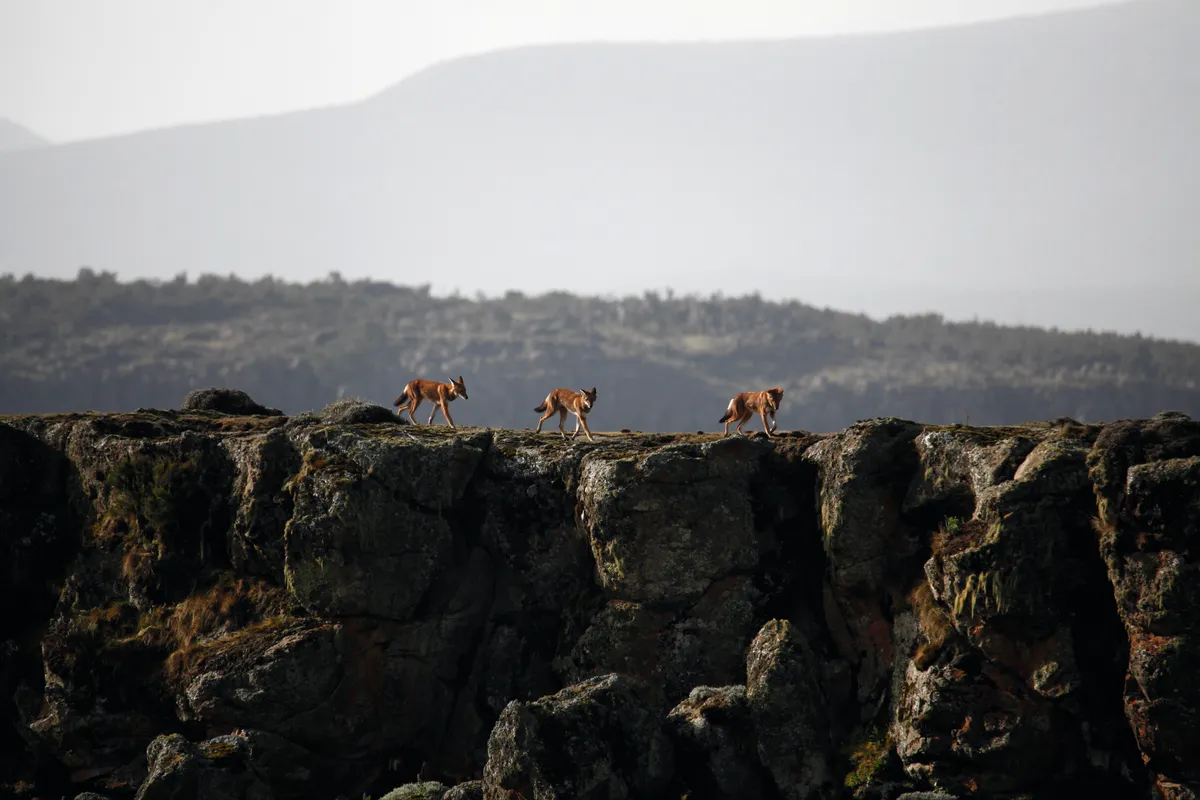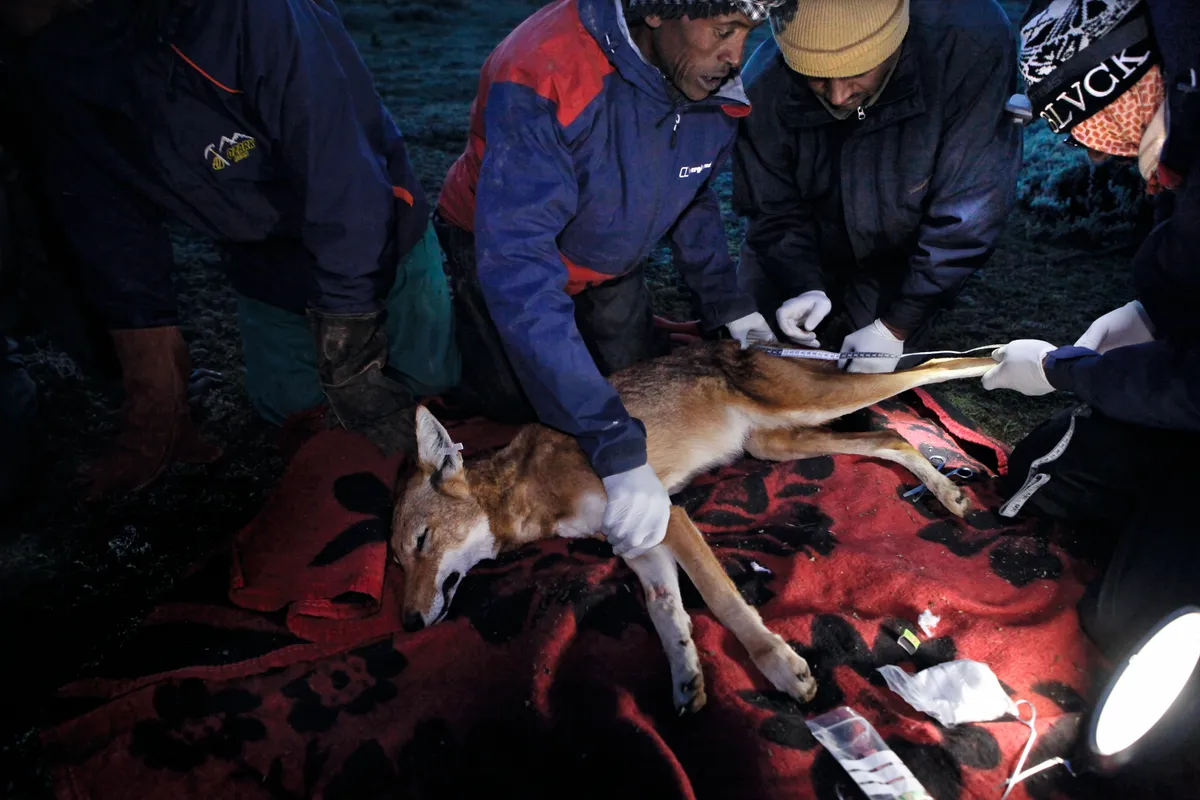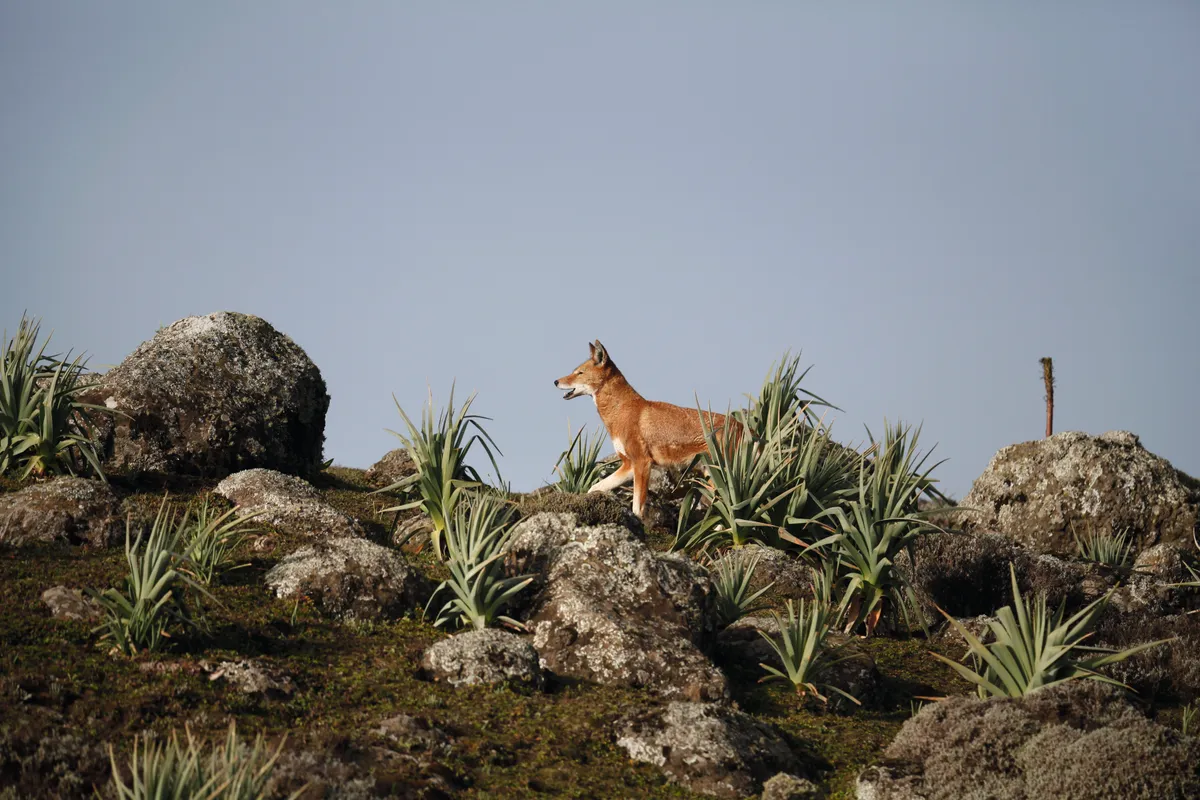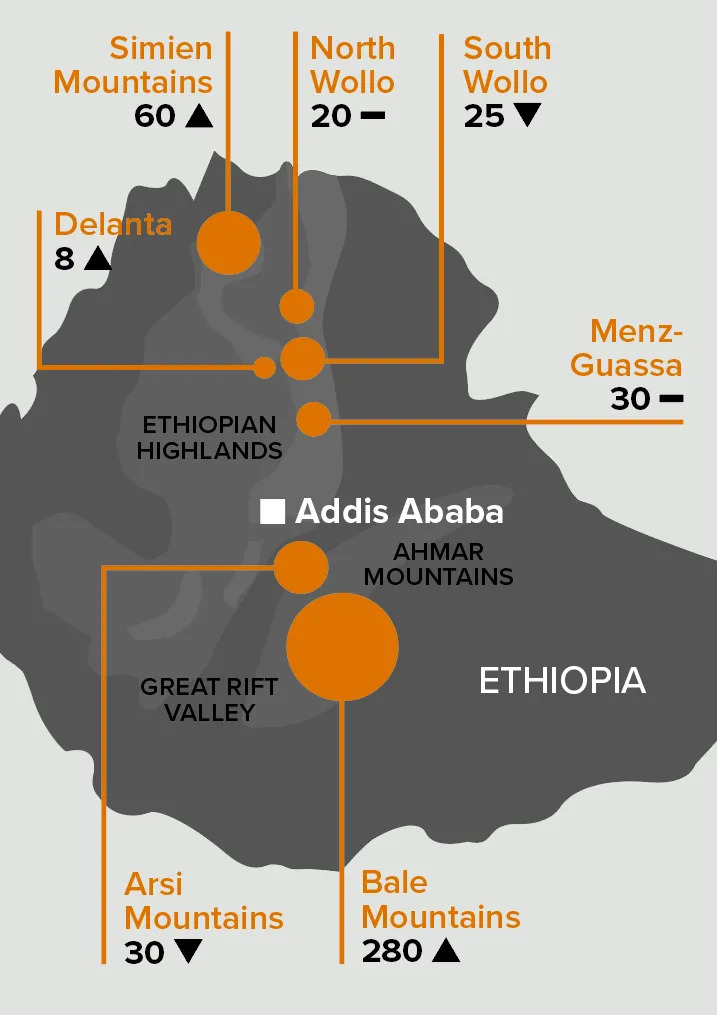"Wake up, wake up! We have a new wolf!” It’s June 2021 and it’s past midnight on the high plateau of West Morebowa, in Ethiopia’s Bale Mountains. We pile out of our tents, eyes bleary.
Muktar Abute, vet team leader for the Ethiopian Wolf Conservation Project (EWCP), grabs his vaccination kit, while the rest of us pull on boots and head torches.
Thunder rolls in the distance as we pick our way down the steep mountain path. We’re at an altitude of almost 4,000m and it’s raining, but the prospect of finding a wolf distracts me from the icy chill.

I’ve made the journey to these remote slopes to document the work of the EWCP, an organisation dedicated to saving the species from extinction. We soon find our quarry, its leg caught in a rubber-edged hold trap. Programme manager Edriss Ebu, joined by field director Eric Bedin, throws a red blanket over the struggling animal to calm it down. The wolf is anaesthetised, released from the trap and moved a few metres away.

Trying to capture all the action on camera is tricky: the rain is still coming down, it’s almost pitch darkness and I am burdened by a large and ungainly poncho. The team from EWCP works fast and in almost complete silence. Keeping a close eye on the wolf’s wellbeing, Muktar performs a brief physical exam, measuring and weighing the animal and examining its teeth, while Eric records the corresponding data. He then checks the identification tag on the wolf’s ear and shaves a small patch of its leg to take a blood sample.
This wolf has no idea that it is helping to save its kind. For this is an Ethiopian wolf, also known as the Abyssinian wolf or ky kebero (in Amharic), which claims the dubious and dual honour of being both the most threatened carnivore in Africa and the rarest canid in the world. Fewer than 500 remain, living in seven small, isolated populations across the highlands of Ethiopia. Its habitat of Afroalpine meadows and heaths is shrinking and becoming increasingly fragmented due to continued encroachment from humans.
Called the Roof of Africa, the Bale Mountains harbour the largest wolf population in Ethiopia. West Morebowa is home to about 50 individuals, spread over eight packs.

The EWCP has been vaccinating domestic dogs and wolves against rabies here since 1996. While this important work continues, the team is also now working on something new – a vaccination trial against the equally deadly Canine Distemper Virus (CDV), which emerged as a serious threat just over a decade ago. The CDV vaccine has been used routinely on domestic dogs, but the EWCP needs to demonstrate that it is also effective on wolves to gain approval for its wider use.
Indeed, protecting dogs and wolves goes hand in hand. As Claudio Sillero, founder of EWCP, explains, dogs are ‘reservoirs’ for both viruses. Brought into the wolves’ Afroalpine home by pastoralists as livestock guardians, they can spill the diseases into local wolf populations, with tragic results. In 2019, a devastating outbreak of CDV affected 19 wolf packs in Bale and, along with an ensuing attack of rabies, killed an estimated 55 individuals. Given the small size of the total population, this came as a huge blow to the conservation effort.

The blanketed wolf in front of me is already part of the CDV trial. The team is lucky to have found it: it was vaccinated in 2020, and its blood will now be tested for antibodies. The health checks are completed and, after an anaesthesia-reversal injection, the wolf wakes up. Our eyes meet for a brief moment, and I’m so caught up in the encounter that I almost forget to take a photograph. I watch as it scampers off and melts into the darkness.
Frozen to the bone, I follow the team on to the next trap, checking periodically for signs of hyenas and leopards. My torch batteries are failing, so I stay close to the others to avoid twisting an ankle in the countless giant mole-rat burrows that pot-hole the path. Suddenly, Eric signals with his torch: another wolf – a juvenile this time – has been caught. I drop to my knees to capture the action. The youngster receives a rabies vaccination and is quickly released.
Setting a wolf trap requires skill and patience. There are eight sets of two traps in the area, positioned a few hundred metres apart across the valley beneath our camp, and checked throughout the night by teams on three-hour shifts. The devices, called Soft Catch traps, are carefully set by monitor team leader Alo Hussein before being disguised with a dusting of soil and adorned with cuttings from Helicrysum bushes. This elaborate ‘garden’ guides the curious and unsuspecting wolves to the meat bait and ensures their capture.

The wolves’ inquisitive nature certainly aids the trapping process, particularly the juveniles. One individual was already sniffing around as Alo was installing his eighth and final set of traps. By sunset, it had been caught, vaccinated and released.
I finally get my head down for the night and Eric promises to wake me if another wolf is caught. It’s unlikely I’ll get much sleep – so effective are the traps that pretty much every time I curl up in my sleeping bag he is tapping on the canvas again.
When I wake at dawn, Sophia, the cook, is already warming flatbread on the open fire. I have barely finished eating before we are on the move and heading down the mountain to another capture. We find a beautiful female, her perfectly sharp and gleaming teeth indicating that she is a young adult (2-3 years old). Her ear tag confirms that she has been vaccinated as part of the trial and a blood sample is collected to check for antibody response, providing yet more valuable data.
After five days running with wolves in West Morebowa, it’s time to move on. There is a clear protocol as to when a trapping effort must come to an end: when the same wolf is caught twice in succession. Trapping expeditions do not take place year-round, only when research is being undertaken or when a rabies outbreak requires a response.

Eric looks tired, but he’s pleased with the results. Of the 10 wolves captured, five are juveniles, each of which has now received a rabies vaccination and four are new recruits to the CDV trial. Going forward, their antibodies will be monitored to assess the effectiveness of the vaccine.
The camp is dismantled with military precision and the four-wheel drives packed to the roofs. We are about to roll out when one of the team spots a dog, accompanied by a young villager on a horse laden with pots and pans. Willingly accepting the offer of a rabies jab, she assists the team as they handle the animal, which, sporting reddish and white coloration, rather resembles its wild wolf relatives. A few seconds later and yet another dog is vaccinated.
Given the increase in the number of free-ranging dogs in Bale in recent years, one more jab may seem a drop in the ocean. Yet long-term research carried out by the EWCP shows that vaccination is making a huge difference in keeping both rabies and CDV under control, and thus helping to save the Ethiopian wolf from extinction. Packs in Bale are breeding well currently, but if either virus hits an unvaccinated population, up to 75 per cent may die. A single bite is all it takes.
Olive baboons and mountain nyalas emerge from bushes and cross the road ahead as we bounce across the rocky landscape towards the mountain village of Gofingira – and to part two of my assignment: joining the dog vaccination team. When the EWCP started its dog vaccination campaign back in 1995, owners were fearful and suspicious, initially refusing the treatment. Today, however, thanks to continued outreach and education, support for the programme has grown considerably, and the EWCP team members are welcomed when they return to the villages each year. Farmers take a break from ploughing to chat and I’m even offered loan of a horse.

Through a megaphone, the village chief calls on Gofingira’s residents to bring in their dogs for either their first vaccination or a booster. He sets an example by getting his own dog treated first, eyed by local children from a distance. The team then visits the village school to teach pupils about vaccination and about Ethiopian wolves. At break time, the playground empties as the children rush home to pick up their dogs for treatment, assisting the team in guiding their pets into the lasso of the grasper pole. They seem to be enjoying themselves.
With the number of domestic dogs near wolf range spiralling upwards in recent years, the vet teams must work overtime to keep the viruses under control. Before the day is out, they have vaccinated more than 200 dogs; in a year, they will treat about 5,000. It’s a remarkable and never-ending effort.
Packs in Bale are breeding well, but if either virus hits an unvaccinated population, up to 75 per cent may die. A single bite is all it takes.
The next day, I accompany Seid Naasiroo from the monitoring team into the green plains of the Web Valley, one of Bale’s wolf strongholds. I’m hoping to see the legendary Tarura pack, which has already survived several outbreaks of rabies and CDV, and is now thriving thanks to vaccination.

We’ve been bouncing along a dry track for a couple of hours when Seid spots a wolf. Yet we push on. He knows from experience that we have to keep going if we’re to find the 11-strong family. Soon, no fewer than nine pointed snouts appear from behind a hill. With their black-and-white markings and red fur, they are fox-like and slighter in build than their closest relative, the grey wolf. Claudio describes them as “wolves in fox’s clothing”. But in terms of social structure and the close bonds between pack members, they are very similar to their grey cousins.
Entranced, I daren’t move a muscle for fear of scaring them away. I inch my camera to my face and spy a frenzy of wolfy greetings: noses are licked, fur is groomed. Led by veteran female TAR02, the wolves trot out on patrol, pausing now and then to scent-mark their territory. At one point they stop and prick up their ears. An intruder has been detected – a large serval cat, prowling the cliff face. The wolves surround the feline, but soon return to the plains, moving smoothly among the cattle as they shift their focus from patrolling to hunting mole-rats.
Ethiopian wolves are a flagship species for the Afroalpine ecosystem. If the wolf and its habitat are protected, the myriad other species found here – many of which are endemic – will benefit. With so few animals left, their future hangs in the balance: every wolf matters. If the EWCP can continue to provide protection against rabies and CDV, they can help to safeguard this wonderful species and its home on the Roof of Africa.
Estimated population sizes

There are currently seven populations of the Ethiopian wolf; all are at risk of extinction due to loss of habitat and disease. The species’ vulnerability is largely due to the size of its populations: though the Bale Mountains house around 280 individuals, the other populations are considerably smaller, with one numbering fewer than 10. Vaccination will always be a key conservation tool, but translocation is another useful strategy, boosting demographic resilience by increasing the size and number of certain wolf populations. Translocations can seek to reinforce existing wolf populations – for example, following an outbreak of disease – or to reintroduce wolves into areas the species occupied in the past. Claudio Sillero.
Find out more about the work of the Ethiopian Wolf Conservation Programme at ethiopianwolf.org
